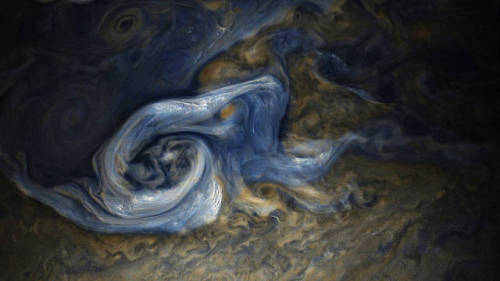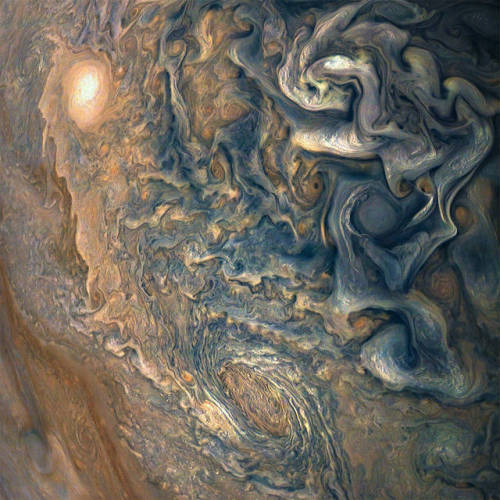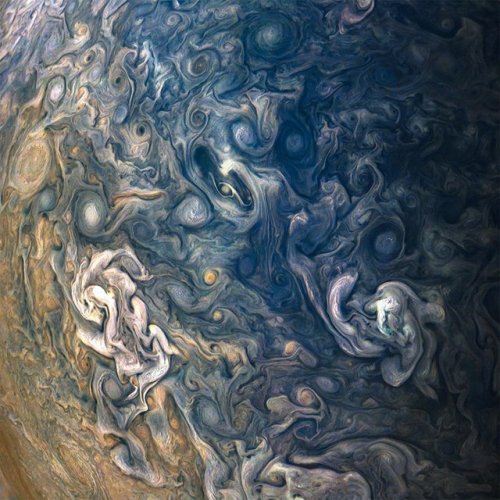Swirls Of Jupiter






Swirls of Jupiter
Jupiter is a very stormy, turbulent, violent planet. The planet completes a day (or one complete rotation) within roughly 10 hours, which creates massive winds, producing these swirls, and violent storms. The fast rotation coupled with the fact that the planet is nothing but gas greatly multiplies the Coriolis effect. Earth too has a Coriolis effect, this creates the characteristic hurricane shapes and also contributes to the fact that storms will spin the opposite direction in different hemispheres. Luckily, our rotation is slower - our storms are less frequent and less violent than they would be if our days were shorter.
The above images come from the recent Juno mission by NASA.
More Posts from Ocrim1967 and Others
50 Reasons It's Time For Smartphones In Every Classroom

“There are many ways to use a smartphone in the classroom, but it continues to be a touchy subject. Privacy, equity, bandwidth, lesson design, classroom management, theft, bullying, and scores of other legitimate concerns continue to cloud education’s thinking about how to meaningfully integrate technology in the learning process.”

The Planets and their respective sizes compared to our Sun.

Three Ways to Travel at (Nearly) the Speed of Light

One hundred years ago, Einstein’s theory of general relativity was supported by the results of a solar eclipse experiment. Even before that, Einstein had developed the theory of special relativity — a way of understanding how light travels through space.
Particles of light — photons — travel through a vacuum at a constant pace of more than 670 million miles per hour.

All across space, from black holes to our near-Earth environment, particles are being accelerated to incredible speeds — some even reaching 99.9% the speed of light! By studying these super fast particles, we can learn more about our galactic neighborhood.
Here are three ways particles can accelerate:
1) Electromagnetic Fields!
Electromagnetic fields are the same forces that keep magnets on your fridge! The two components — electric and magnetic fields — work together to whisk particles at super fast speeds throughout the universe. In the right conditions, electromagnetic fields can accelerate particles at near-light-speed.

We can harness electric fields to accelerate particles to similar speeds on Earth! Particle accelerators, like the Large Hadron Collider and Fermilab, use pulsed electromagnetic fields to smash together particles and produce collisions with immense amounts of energy. These experiments help scientists understand the Big Bang and how it shaped the universe!
2) Magnetic Explosions!

Magnetic fields are everywhere in space, encircling Earth and spanning the solar system. When these magnetic fields run into each other, they can become tangled. When the tension between the crossed lines becomes too great, the lines explosively snap and realign in a process known as magnetic reconnection. Scientists suspect this is one way that particles — for example, the solar wind, which is the constant stream of charged particles from the Sun — are sped up to super fast speeds.

When magnetic reconnection occurs on the side of Earth facing away from the Sun, the particles can be hurled into Earth’s upper atmosphere where they spark the auroras.
3) Wave-Particle Interactions!

Particles can be accelerated by interactions with electromagnetic waves, called wave-particle interactions. When electromagnetic waves collide, their fields can become compressed. Charged particles bounce back and forth between the waves, like a ball bouncing between two merging walls. These types of interactions are constantly occurring in near-Earth space and are responsible for damaging electronics on spacecraft and satellites in space.

Wave-particle interactions might also be responsible for accelerating some cosmic rays from outside our solar system. After a supernova explosion, a hot, dense shell of compressed gas called a blast wave is ejected away from the stellar core. Wave-particle interactions in these bubbles can launch high-energy cosmic rays at 99.6% the speed of light.
Make sure to follow us on Tumblr for your regular dose of space: http://nasa.tumblr.com.










Ask Ethan: Why Do Gravitational Waves Travel Exactly At The Speed Of Light?
We know that the speed of electromagnetic radiation can be derived from Maxwell’s equation[s] in a vacuum. What equations (similar to Maxwell’s - perhaps?) offer a mathematical proof that Gravity Waves must travel [at the] speed of light?
If you were to somehow make the Sun disappear, you would still see its emitted light for 8 minutes and 20 seconds: the amount of time it takes light to travel from the Sun to the Earth across 150,000,000 km of space. But what about gravitation? Would the Earth continue to orbit where the Sun was for that same 8 minutes and 20 seconds, or would it fly off in a straight line immediately?
There are two ways to look at this puzzle: theoretically and experimentally/observationally. From a theoretical point of view, this represents one of the most profound differences from Newton’s gravitation to Einstein’s, and demonstrates what a revolutionary leap General Relativity was. Observationally, we only had indirect measurements until 2017, where we determined the speed of gravity and the speed of light were equal to 15 significant digits!
Gravitational waves do travel at the speed of light, which equals the speed of gravity to a better precision than ever. Here’s how we know.
Your Gut in Space
Finding the Right Balance for the Microbiota
Trillions of microorganisms live on and in the human body, many of them essential to its function and health. These organisms, collectively known as the microbiota, outnumber cells in the body by at least five times.

Microorganisms in the intestinal tract, the gut microbiota, play an especially important role in human health. An investigation on the International Space Station, Rodent Research-7 (RR-7), studies how the gut microbiota changes in response to spaceflight, and how that change in turn affects the immune system, metabolic system, and circadian or daily rhythms.

Research shows that the microbiota in the mammalian digestive tract has a major impact on an individual’s physiology and behavior. In humans, disruption of microbial communities has been linked to multiple health problems affecting intestinal, immune, mental and metabolic systems.

The investigation compares two different genetic strains of mice and two different durations of spaceflight. Twenty mice, ten of each strain, launch to the space station, and another 20 remain on the ground in identical conditions (except, of course, for the absence of gravity). Mice are a model organism that often serves as a scientific stand-in for other mammals and humans.

Fecal material collected from the mice every two weeks will be examined for changes in the gut microbiota. Researchers plan to analyze fecal and tissue samples after 30 and 90 days of flight to compare the effects of different durations of time in space.

With a better understanding of relationships between changes such as disruption in sleep and an imbalance of microbial populations, researchers can identify specific factors that contribute to changes in the microbiota. Further studies then can determine proactive measures and countermeasures to protect astronaut health during long-term missions.

Make sure to follow us on Tumblr for your regular dose of space: http://nasa.tumblr.com.
All Cats Are Beautiful




























Not Only Didn’t We Find Water On An Earth-Like Exoplanet, But We Can’t With Current Technology
“Over the past few decades, astronomers have uncovered thousands of new exoplanets. Some of them are rocky; some are temperate; some have water. However, the idea that exoplanet K2-18b is rocky, Earth-like, and has liquid water is absurd, despite recent headlines. Light filters through K2-18b’s atmosphere when it passes in front of its star, enabling us to measure what’s absorbed. Based on those absorption lines, the presence of many chemicals can be inferred, including water. K2-18b is, truly, the first known habitable-zone exoplanet to contain water. However, it is not rocky; its mass and radius are too large, necessitating a large gas envelope around it.”
How incredible was that report that came out last week: the first Earth-like, rocky exoplanet with liquid water on its surface has been discovered! If it were true, it would be incredible. Well, what we did find is still pretty remarkable, but it’s very different from what you’ve likely heard.
We did find water on the exoplanet in question, K2-18b, but only in the vapor phase and only in the atmosphere.
The exoplanet is closer to Earth in terms of mass and radius than any other with water on it, but the planet is still too massive and large to be rocky. It must have an envelope of hydrogen and helium, and both have had their presence detected.
If we want to find atmospheric biosignatures around Earth-like worlds, we need better observatories. Let’s build them! Here’s the real story.





Read Full Article Here: 6 Tricks to Staying Positive - Psych2Go
Follow @psych2go for more








-
 potatoinajacket liked this · 2 months ago
potatoinajacket liked this · 2 months ago -
 delicatefreakbanditranch reblogged this · 2 months ago
delicatefreakbanditranch reblogged this · 2 months ago -
 ditchersblog liked this · 3 months ago
ditchersblog liked this · 3 months ago -
 alexpozi liked this · 4 months ago
alexpozi liked this · 4 months ago -
 jegrep liked this · 4 months ago
jegrep liked this · 4 months ago -
 yanngi liked this · 5 months ago
yanngi liked this · 5 months ago -
 jjam1963 liked this · 6 months ago
jjam1963 liked this · 6 months ago -
 fuzzychaoscollectorstuff reblogged this · 8 months ago
fuzzychaoscollectorstuff reblogged this · 8 months ago -
 geezcheese liked this · 8 months ago
geezcheese liked this · 8 months ago -
 pissed143 liked this · 9 months ago
pissed143 liked this · 9 months ago -
 zippy1971 liked this · 9 months ago
zippy1971 liked this · 9 months ago -
 trollduster liked this · 9 months ago
trollduster liked this · 9 months ago -
 tindesy liked this · 10 months ago
tindesy liked this · 10 months ago -
 gcey liked this · 10 months ago
gcey liked this · 10 months ago -
 gr00vygemiinii liked this · 11 months ago
gr00vygemiinii liked this · 11 months ago -
 westernstarofthenorth reblogged this · 1 year ago
westernstarofthenorth reblogged this · 1 year ago -
 westernstarofthenorth liked this · 1 year ago
westernstarofthenorth liked this · 1 year ago -
 charadriusnivosus reblogged this · 1 year ago
charadriusnivosus reblogged this · 1 year ago -
 qualifiedscooter reblogged this · 1 year ago
qualifiedscooter reblogged this · 1 year ago -
 qualifiedscooter liked this · 1 year ago
qualifiedscooter liked this · 1 year ago -
 willemsjw1980 liked this · 1 year ago
willemsjw1980 liked this · 1 year ago -
 sidewalkbeat reblogged this · 1 year ago
sidewalkbeat reblogged this · 1 year ago -
 amorcitocorazon reblogged this · 1 year ago
amorcitocorazon reblogged this · 1 year ago -
 driftcrazy87 liked this · 1 year ago
driftcrazy87 liked this · 1 year ago -
 pi-ters liked this · 1 year ago
pi-ters liked this · 1 year ago -
 onthesun18 reblogged this · 1 year ago
onthesun18 reblogged this · 1 year ago -
 brotherhoodentertainment reblogged this · 1 year ago
brotherhoodentertainment reblogged this · 1 year ago -
 untitt liked this · 1 year ago
untitt liked this · 1 year ago -
 tornadoquest reblogged this · 1 year ago
tornadoquest reblogged this · 1 year ago -
 alicefrom3am reblogged this · 1 year ago
alicefrom3am reblogged this · 1 year ago -
 imkindatiredsooo reblogged this · 1 year ago
imkindatiredsooo reblogged this · 1 year ago -
 bibabom liked this · 1 year ago
bibabom liked this · 1 year ago -
 dustyphotographer liked this · 1 year ago
dustyphotographer liked this · 1 year ago -
 otterwerx reblogged this · 1 year ago
otterwerx reblogged this · 1 year ago -
 spidergoatduex reblogged this · 1 year ago
spidergoatduex reblogged this · 1 year ago -
 spidergoatduex liked this · 1 year ago
spidergoatduex liked this · 1 year ago -
 girlyboyfosho liked this · 1 year ago
girlyboyfosho liked this · 1 year ago -
 laineydiemond liked this · 1 year ago
laineydiemond liked this · 1 year ago -
 kokmd29 liked this · 1 year ago
kokmd29 liked this · 1 year ago -
 queerkataguiri liked this · 1 year ago
queerkataguiri liked this · 1 year ago